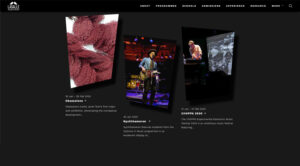What is Composable Commerce?
Composable commerce is a revolutionary approach to building and customising e-commerce solutions, with best-of-breed “Packaged Business Capabilities” (PBCs) that snap together seamlessly to create unique and flexible capabilities.
Unlike traditional platforms where everything’s crammed together, composable commerce separates the front end (what you see) from the back end (the engine powering it). This lets you mix and match PBCs from different vendors, like a headless CMS for content, a payment gateway for checkout, and a product information management system for data.
PBCs are laser-focused on specific functionalities, like product recommendations, cart management, or loyalty programmes. You only pick what you need, ditching the bloatware and tailoring the platform to your precise business requirements. The modular nature of PBCs lets you easily adapt to changing needs and trends. Want to add a new payment option? Swap out the PBC. Need to personalise product recommendations? Plug in a different one. No more costly platform overhauls, just seamless upgrades and enhancements.
What’s great?
Here are some key benefits that you get with composable commerce:
Agility and Speed:
Up to 50% reduction in time to market for new features
MachNation repor
- Lego-like Assembly: Think of building your storefront with best-of-breed PBCs like modular building blocks. This lets you add new features, update functionalities, and adapt to changing trends much faster than with traditional monolithic platforms.
- No More Overhauls: Forget costly and time-consuming platform upgrades. With composable commerce, you can simply swap out or add PBCs as needed, keeping your store future-proof and always evolving.
Flexibility and Choice:
15% increase in average order value through personalised experiences
Unilever case study
- Pick and Choose: You’re not locked into a single vendor or limited feature set. Choose the PBCs that perfectly match your specific needs and business goals, creating a truly unique and tailored online shopping experience.
- Innovation Playground: Embrace the latest and greatest innovations without waiting for platform updates. New PBCs are constantly emerging, allowing you to stay ahead of the curve and offer cutting-edge features to your customers.
Enhanced Efficiency and Cost Savings:
- Reduced Bloatware: Ditch the features you don’t need and only pay for the functionalities you use. This cuts down on unnecessary costs and improves the overall performance of your e-commerce platform.
- Easier Maintenance: Modular architecture makes troubleshooting and updating individual PBCs much easier, reducing maintenance costs and freeing up your IT team for more strategic tasks.
Improved Customer Experiences:
20% higher conversion rates due to seamless omnichannel experiences
Decathlon case study
- Personalisation Powerhouse: Easily integrate PBCs for personalised product recommendations, dynamic content delivery, and targeted promotions, leading to more engaging and relevant shopping experiences for your customers.
- Omnichannel Mastery: Create seamless shopping journeys across all touchpoints, whether it’s mobile, web, or in-store, by choosing PBCs specifically designed for omnichannel commerce.
Overall, composable commerce offers a future-proof approach to building and managing commerce platforms, empowering businesses with agility, flexibility, and enhanced customer experiences.
The challenges!
But while the benefits are significant, composable commerce also presents some challenges. Here are some key hurdles to consider:
45% of businesses cite increased complexity as a top concern with composable commerce
Acquia survey
Increased Complexity: Unlike the “simplicity” of traditional platforms, composable commerce requires managing and integrating multiple independent PBCs. This can introduce complexity, especially for organisations with limited technical expertise. API sprawl, data synchronisation across PBCs, and robust security measures all require careful planning and execution.
Vendor Management: With a pick-and-mix approach, you’re dealing with multiple vendors, each with its support structure and SLAs. This can make troubleshooting and managing contractual agreements more intricate compared to a single-platform solution.
Integration Headaches: Ensuring seamless integration between various PBCs can be a technical hurdle. Incompatible APIs, data inconsistencies, and performance bottlenecks can disrupt the smooth functioning of your online store.
Security Concerns: A decentralised architecture with multiple data sources necessitates robust security measures. Careful access control, data encryption, and threat monitoring are crucial to prevent vulnerabilities and protect customer information.
Cost Considerations: While composable commerce can save money in the long run by eliminating bloatware, the initial setup and integration costs can be higher than traditional platforms. Additionally, ongoing maintenance and licensing fees for multiple PBCs need to be factored in.
70% of organisations need to upskill their IT teams to manage composable architectures
MachNation report
Talent Acquisition: Building and managing a composable commerce platform often requires specialised skills like API integration, microservices architecture expertise, and strong security know-how. Hiring or upskilling existing talent can be a challenge for some organisations.
Data Governance: Managing data across different PBCs requires a robust data governance strategy. Ensuring data consistency, accuracy, and compliance with regulations is crucial for smooth operation and customer trust.
However, these challenges shouldn’t deter you from exploring the potential of composable commerce for your needs. With careful planning, utilising the right tools and strategies, and with the right team, these hurdles can be overcome efficiently. And the benefits of agility, flexibility, and future-proofing your online store can outweigh the initial complexities.
So, who is it for?
Composable commerce isn’t a one-size-fits-all solution, but it presents exciting opportunities for a specific set of players in the e-commerce world, such as:
Forward-Thinking Companies: For businesses embracing constant innovation and adaptation, composable commerce’s flexibility shines. It allows them to easily integrate new technologies and features, staying ahead of the curve in a fast-changing landscape.
B2B Players: With the growing demand for personalised B2B experiences, composable commerce allows tailoring storefronts and workflows for specific customer segments, leading to enhanced relationships and sales.
E-commerce Brands Seeking Differentiation: If standing out from the crowd is your goal, composable commerce grants you the freedom to craft unique and engaging shopping experiences that truly reflect your brand identity.
Companies Battling Legacy Systems: Struggling with outdated platforms and inflexible functionalities? Composable commerce offers a way to gradually modernise your tech stack, replacing individual components without ripping everything down and starting over.
Tech-Savvy Businesses: Composable architecture thrives on strong API integration and technical expertise. Businesses with qualified IT support comfortable with managing a modular tech stack are prime candidates.
Here, are a few real-world success stories across different industries:
40% of e-commerce leaders considering adopting composable commerce within the next two years
Acquia survey
B2B Powerhouse: Bosch Home Appliances used composable commerce to create personalised B2B storefronts for different trade partners, like contractors and architects. This resulted in a 20% increase in order value and enhanced customer satisfaction with tailored product selections and pricing.
Luxury Reinvented: Richemont, the luxury conglomerate housing Cartier and Dunhill, adopted composable commerce to craft unique online experiences for each brand, reflecting their distinct identities. This led to a 30% rise in mobile conversions and enhanced brand differentiation.
Omnichannel Mastery: Decathlon, the sporting goods giant, embraced composable commerce to seamlessly integrate its online and offline channels. This allowed customers to reserve items online for in-store pickup, driving foot traffic and boosting overall sales.
Personalisation on Steroids: Unilever, the consumer goods giant, used composable commerce to personalise product recommendations and promotions based on individual customer data. This resulted in a 15% increase in average order value and improved customer engagement.
The Global Market size of composable commerce is expected to reach $16.5 billion by 2027, growing at a CAGR of 33.6%
Grand View Research
Future-Proofed Growth: Farfetch, the luxury online marketplace, adopted composable commerce to rapidly integrate new brands and functionalities into their platform. This agility allowed them to stay ahead of trends and maintain their position as a leading fashion destination.
Key Takeaways
Composable commerce lets you ditch the one-size-fits-all approach and build an e-commerce platform that’s as unique and dynamic as your business. It’s about agility, flexibility, and future-proofing your online store for whatever the future of commerce throws your way.
And whether you embrace composable commerce or not, its emergence signals a shift towards greater flexibility and agility in the e-commerce landscape. Even if you choose a different path, understanding the principles and potential of composable commerce can still equip you for the future of online shopping.
Ultimately, the decision to adopt the composable commerce approach depends on your business goals, technical capabilities, and willingness to embrace a new, more nuanced approach to e-commerce. Weigh the benefits and challenges carefully, and don’t hesitate to seek expert advice to determine if composable commerce is the right fit for you.


